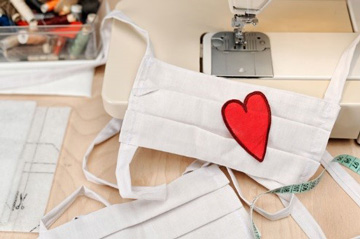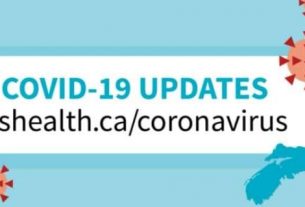**** Health Canada Release
Considerations in the use of homemade masks to protect against COVID-19
Notice to General Public and Healthcare Professionals
Health Canada is advising the public, as well as healthcare professionals (HCPs) on important considerations for the use of homemade masks to protect against the transmission of COVID-19.
Wearing a facial covering/non-medical mask in the community has not been proven to protect the person wearing it and is not a substitute for physical distancing and hand washing. However, it can be an additional measure you can take to protect others around you, even if you have no symptoms. It can be useful for short periods of time, when physical distancing is not possible in public settings such as when grocery shopping or using public transit.
Strict hygiene and public health measures, including frequent hand washing and physical (social) distancing, will reduce your chance of being exposed to the virus.
Homemade masks may include those that are:
- made of cloth e.g., cotton
- with pockets to insert other masks or filters
- to be worn over N95 respirators (in an effort to reuse respirators)
Homemade masks are not medical devices, and consequently, are not regulated like medical masks and respirators. Their use poses a number of limitations:
- they have not been tested to recognized standards
- they may not provide complete protection against virus-sized particles
- the edges are not designed to form a seal around the nose and mouth
- the fabrics are not the same as used in surgical masks or respirators
- they can be difficult to breathe through and can prevent you from getting the required amount of oxygen needed by your body
These types of masks may not be effective in blocking virus particles that may be transmitted by coughing, sneezing or certain medical procedures. They do not provide complete protection from virus particles because of a potential loose fit and the materials used.
Medical masks, including surgical, medical procedure face masks and respirators (like N95 masks), must be kept for healthcare workers and others providing direct care to COVID-19 patients.
U.S. National Institute for Occupational Safety and Health (NIOSH) or equivalent approved N95 surgical respirators are designed to reduce the risk of inhaling hazardous airborne particles and aerosols. These respirators are medical devices authorized by Health Canada. An N95 respirator is a respiratory protective device designed to achieve a very close facial fit and very efficient filtration of airborne particles. The ‘N95’ designation means that when subjected to careful testing the respirator blocks at least 95% of very small test particles.
Medical masks are also medical devices that use materials that block at least 95% of very small test particles, however, they do not fit tightly to the face, so are not designed to provide complete protection for the wearer. Both respirators and masks need to be used in combination with appropriate eye protection (e.g., face shield, goggles) to achieve full protection of the eyes, nose and mouth.
Health Canada has provided important information on optimizing the use of masks and respirators during the COVID-19 outbreak.
The Public Health Agency of Canada has additional guidance on wearing masks to prevent COVID-19 that includes the following:
- Wearing a non-medical mask is an additional measure you can take to protect others around you (in situations where physical distancing is difficult to maintain given recent evidence related to transmission from persons who are pre-symptomatic or have no symptoms).
- Wearing a non-medical mask is another way to cover your mouth and nose to prevent your respiratory droplets from contaminating others or landing on surfaces. Just like our recommendation not to cough into your hands (instead, cover your cough with tissues or your sleeve) a mask can reduce the chance that others are coming into contact with your respiratory droplets.
- If wearing a non-medical mask makes you feel safer and stops you from touching your nose and mouth, that is also good. But remember not to touch or rub your eyes.
- It is important to understand that non-medical masks have limitations and need to be used safely.
- If you choose to use a non-medical face mask:
- you must wash your hands immediately before putting it on and immediately after taking it off (in addition to practicing good hand hygiene while wearing it)
- it should fit well (non-gaping)
- you should not share it with others
- Face masks can become contaminated on the outside, or when touched by your hands. When wearing a mask, take the following precautions to protect yourself:
- avoid touching your face mask while using it
- change a cloth mask as soon as it gets damp or soiled
- put it directly into the washing machine or a bag that can be emptied into the washing machine and then disposed of
- cloth masks can be laundered with other items using a hot cycle, and then dried thoroughly.
- non-medical masks that cannot be washed should be discarded and replaced as soon as they get damp, soiled or crumpled
- dispose of masks properly in a lined garbage bin
- don’t leave discarded masks in shopping carts, on the ground, etc.
For further advice and resources, please visit the Government of Canada COVID-19 website




